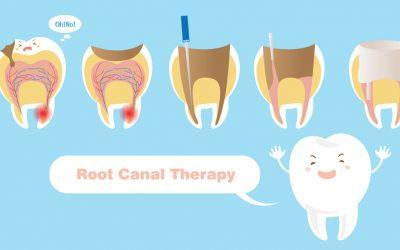
Our culture places a great deal of fear around the idea of a root canal. It has become synonymous with anything painful and uncomfortable. Much has changed in dentistry over the years however, and root canal procedures and management of discomfort have improved significantly. Understanding the procedure start to finish can go a long way in helping to ease the nerves.
What Is A Root Canal?
When a tooth is damaged due to neglect, decay or injury, a root canal is done in order to save the tooth from having to be removed, allowing you to keep the natural tooth structure. Once a cavity has spread through the enamel and dentin to the tooth’s nerve tissue within the pulp chamber, painful infections or an abscessed tooth caused by bacteria growing around the nerve is almost always the result.
If the infected tooth is left untreated, the following complications will eventually occur:
-Swelling
-Bone loss around the tip of the root
-Severe tooth pain
-Discoloration of the tooth
-Increased sensitivity to hot or cold temperature
-The infection drains into the gums or the cheek
-The living tooth will die and decay
What Happens During A Root Canal?
Depending on the condition of your infected tooth and your history with the dentist, a root canal procedure will generally take one or two visits. The first step is getting a local anesthetic to numb the infected area. The dentist will make sure that the area has been sufficiently numbed. Then, a rubber dam may be placed surrounding the tooth being worked on so that harmful bacteria is kept out. A small hole will be created in the tooth to gain access to the root canal. Once the damaged area can be reached, the pulp (nerve) will be cleared out by our specialists, and the canal will be thoroughly cleaned. Specially shaped files will be used to clear away the infected nerve tissue. The empty pulp and root canals will then be thoroughly disinfected. Once all of the infected areas are removed, the now clean and empty area will be filled. The hole that was created to reach the infection will then be covered up with a filling. Depending on where in your mouth the root canal took place, a filling and or a crown will be needed in order to protect the tooth from further damage.
Tips To Follow After Root Canal Treatment:
-Sometimes it’s not always possible to reach all of the infected areas. Taking any prescribed antibiotics is essential to prevent further infection.
-If you experience pain after the procedure for an extended period of time, call your dentist right away.
-Follow proper hygiene habits and clean the tooth and gums regularly where your root canal occurred. Use a fluoride toothpaste and brush for a full two minutes. Follow up by gently flossing between each tooth to remove any built-up food in the gaps
-Avoid putting too much pressure on the side of your mouth where you had your root canal. Steer away from foods that are chewy, hard or crunchy. Give your tooth time to heal.
Schedule an Appointment
Drs. Chris and Beth Clark at Clark Family Dental focus not only on your comfort but also your health and the health of your teeth. Our New Albany, OH dental office serves patients from surrounding New Albany communities. Contact us today to schedule an appointment and let us restore health and comfort to your mouth.




